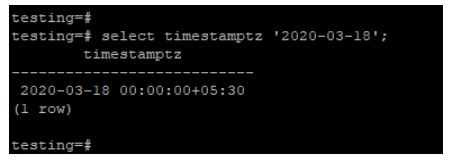

Let us first understand the anatomy of a timestamp and break down the timestamp to extract each of the parts into different columns.Įxtracts the year part from the timestamp.Įxtracts the milliseconds from the timestamp.Īs explained in the above table, the timestamp can be broken down into these parts. Since I am in Dublin, my time zone is UTC+1 (summertime). Let us first understand how a timestamp column looks like in PostgreSQL.įigure 1 – Sample Timestamp example in PostgreSQL with time zone informationĪs you can see in the figure above, we have used the now() function in PostgreSQL that returns the current time of the system.

Sometimes it is required that we do not use the entire timestamp for analysis, instead just use a part of it, for example, a day or an hour. These columns can be with or without time zone information. While working on a large database project, often we come across multiple columns that store data in timestamp format. Using the CAST function in PostgreSQL to convert timestamps to other formats Using the INTERVAL function in PostgreSQL In this article, we are going to focus on the following concepts.Įxtract date parts from existing timestamps Also, we can calculate time intervals using these functions that will help us analyze what has changed between those two timeframes. PostgreSQL provides a number of different date and time functions by default that can be used to calculate these kinds of KPIs. PostgreSQL is one of the leading open-source relational database systems that can be used to build operational databases as well as data warehouses. In this article, we are going to explore some of the important Date and Time functions that can be used in PostgreSQL and how they can be implemented henceforth. These KPIs help businesses understand and gauge their performance and also aids in making decisions necessary for their development. Some of the most commonly used KPIs that involve date and time calculations are monthly sales, quarterly web traffic, year-over-year growth etc. Be it financial data or any data related to sales, dates always play a pivotal role in analyzing the trends and hence draw a pattern out from them. Working with Date and Time calculations is an integral part of any Data Analytics solution.


 0 kommentar(er)
0 kommentar(er)
